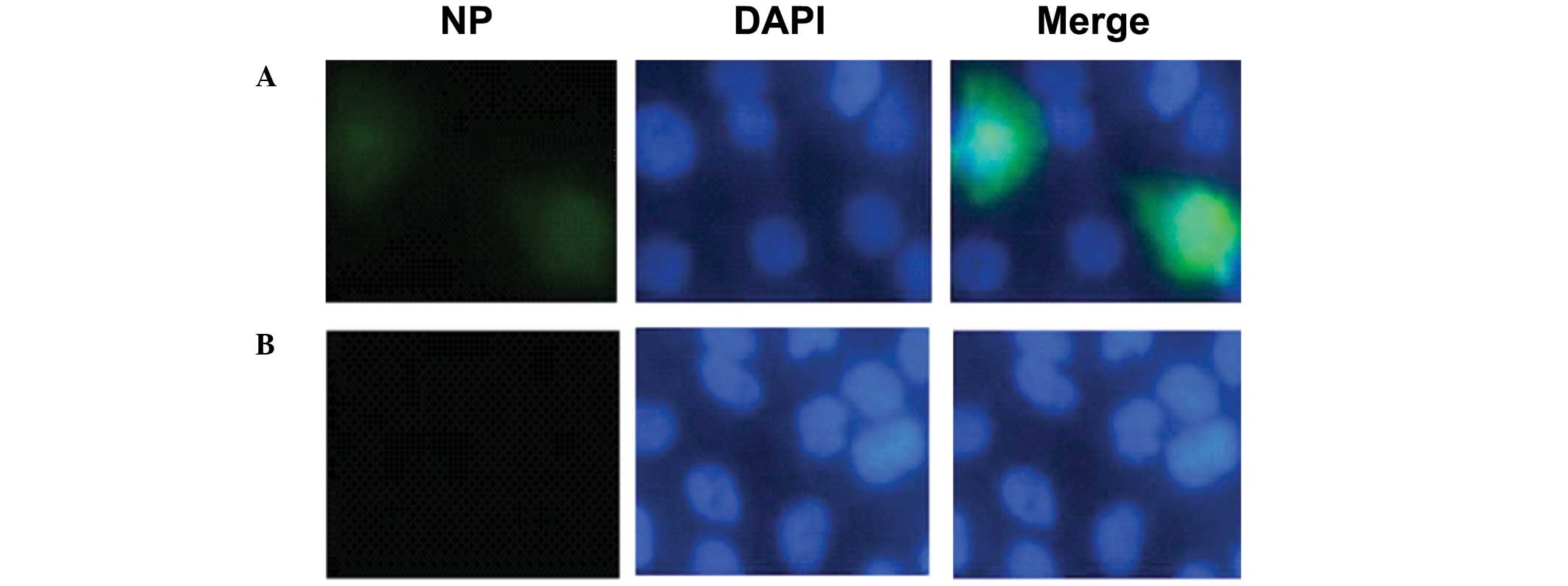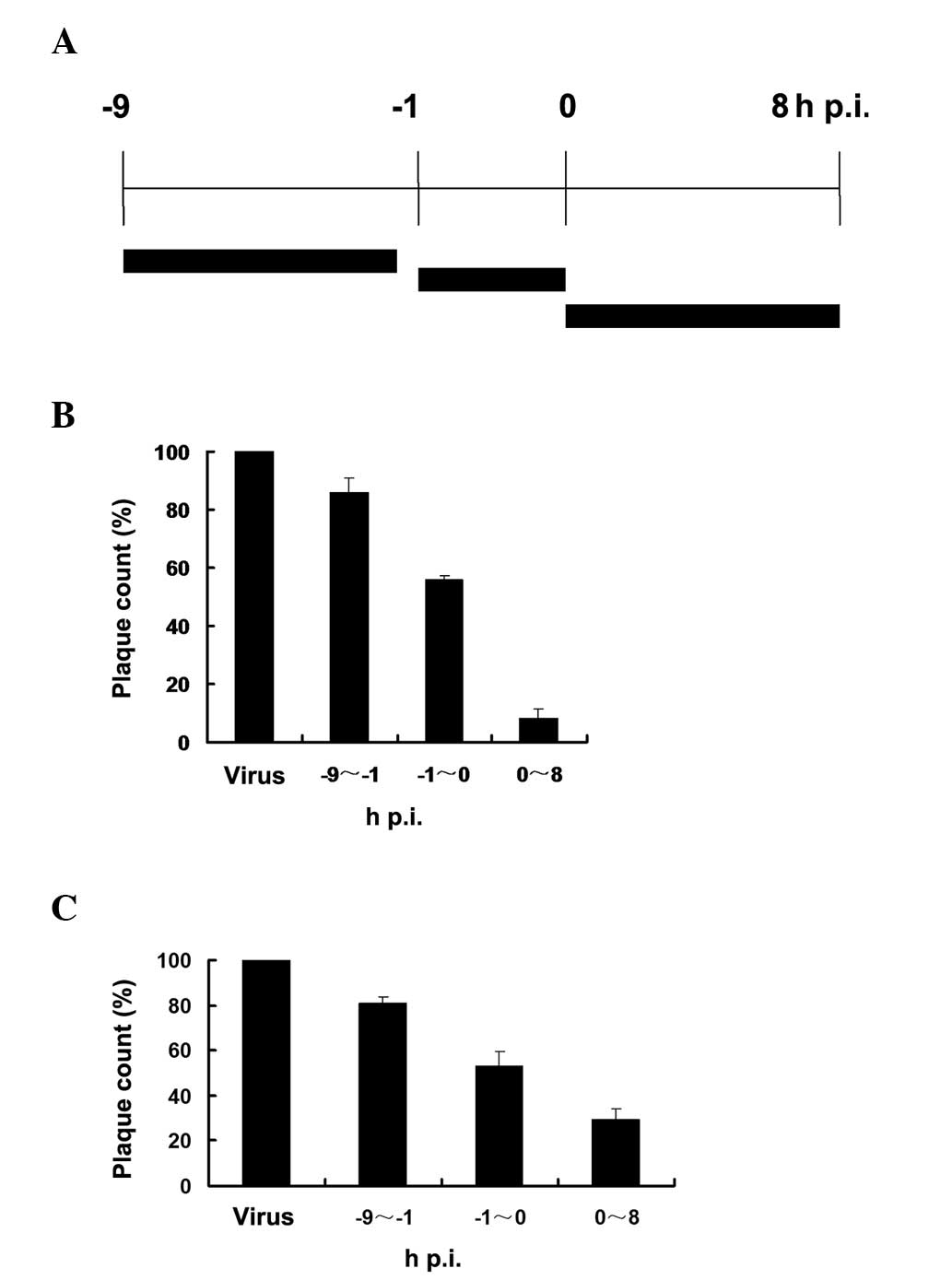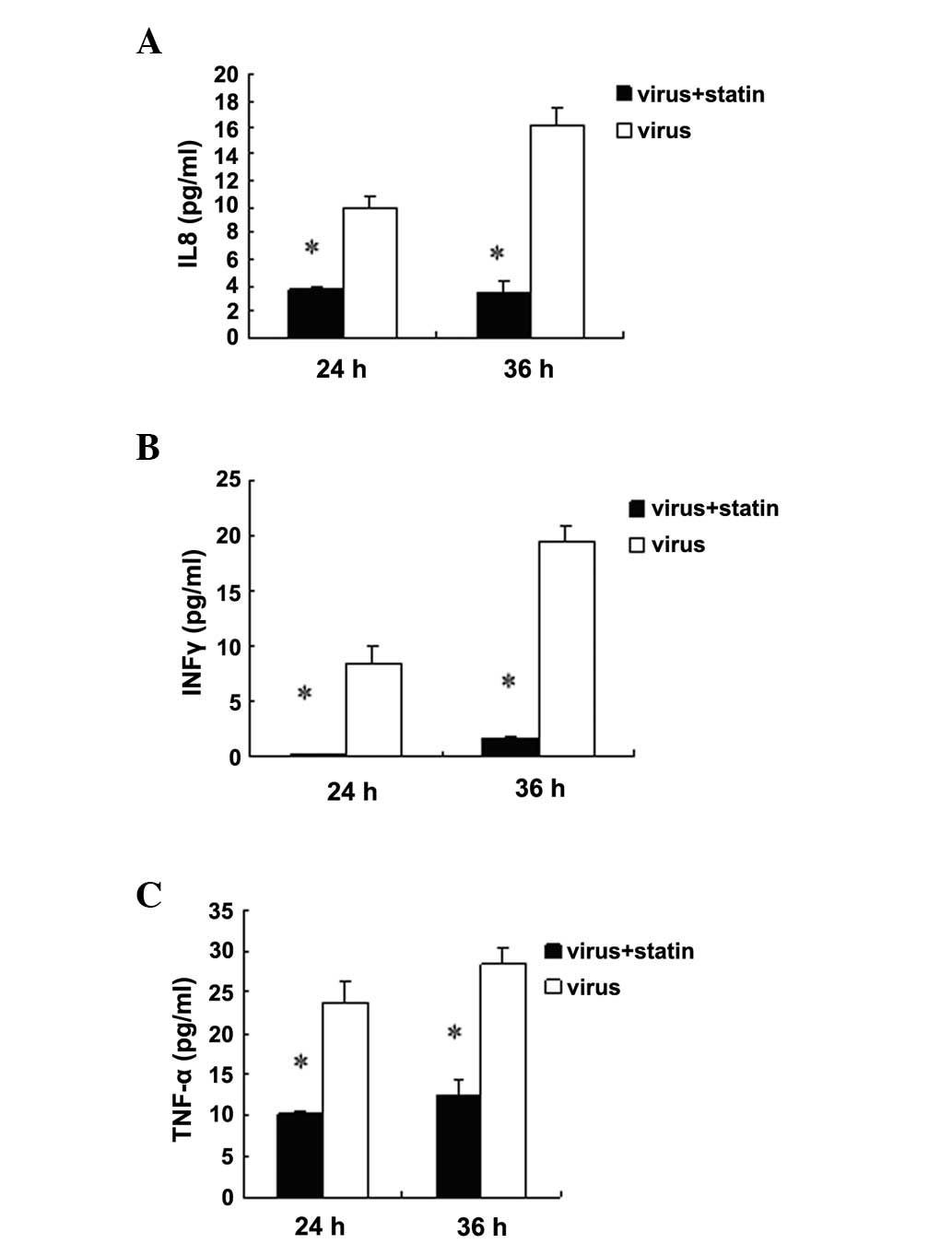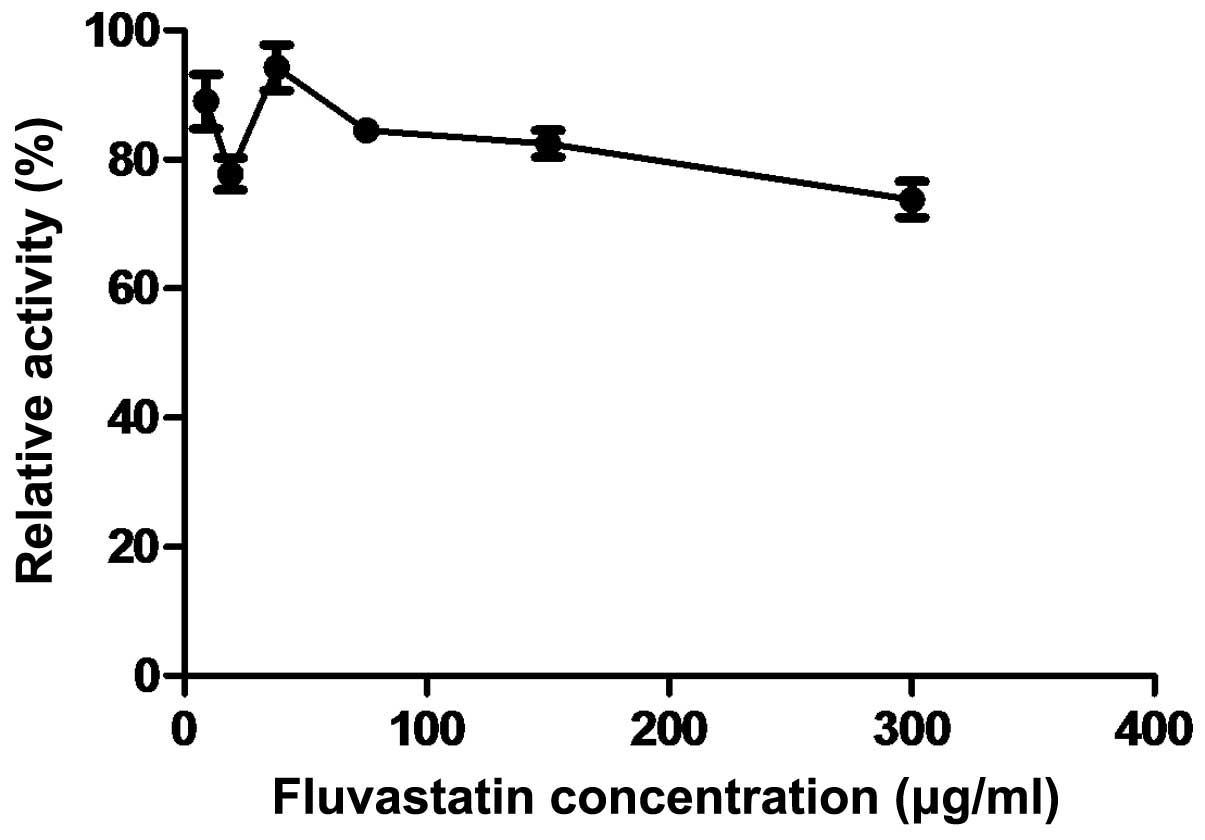Protective effect of fluvastatin on influenza virus infection
- Authors:
- Published online on: March 27, 2014 https://doi.org/10.3892/mmr.2014.2076
- Pages: 2221-2226
Abstract
Introduction
In July 2009, the World Health Organization (WHO) declared a pandemic due to a novel influenza virus, haemagglutinin type 1 and neuraminidase type 1 (H1N1) (1), which raised serious public concern (2). At present, vaccines and anti-influenza drugs are used for the treatment and prevention of influenza (3,4). However, the number of vaccines currently available is insufficient. Failure to anticipate the circulating strains also reduces the efficacy of the vaccines (5,6). Two classes of approved antiviral drugs are available at present, neuraminidase inhibitors and M2 channel inhibitors (7). However, the use of these drugs is limited due to the emergence of drug-resistant viruses (8,9); therefore, the development of novel, effective antiviral drugs is critical in order to control and treat influenza infections.
Statins are 3-hydroxy-3-methylglutaryl coenzyme A (HMG-CoA) reductase inhibitors, and are widely used in lipid-lowering therapy. Studies have shown that statins have pleiotropic effects (10–12), including anti-inflammatory and immunomodulatory effects, which may provide a potential therapeutic treatment against influenza (13). Influenza infection is characterized by increased plasma concentrations of proinflammatory cytokines, known as a ‘cytokine storm’ (14). Anti-inflammatory and immunomodulatory agents are potential antiviral drugs. Statins have been shown to exert antimicrobial effects against certain organisms, and they have also been reported to be active against a broad spectrum of viruses (15,16). In addition, observational studies have suggested that statins may reduce mortality in patients with influenza (17,18). We previously reported that a statin/caffeine combination protects BALB/c mice against H5N1, H3N2 and H1N1 infection. The effect of statin alone on influenza virus infection; however, is not known. Fluvastatin is a member of the statin family. In this study, the inhibition effect of fluvastatin on influenza A virus infection was investigated, as well as the mechanism of action in cultured cells.
Materials and methods
Cells, virus strains and reagents
Madin-Darby canine kidney (MDCK) cells and a human epithelial lung cell line (A549) obtained from the Experimental Animal Center of Sun Yat-sen University (Guangzhou, China) were grown in minimum essential medium (MEM; Invitrogen Life Technologies, Carlsbad, CA, USA) and Dulbecco’s Modified Eagle medium/Nutrient Mixture F12 (DMEM/F12; Hyclone, Thermo Fisher Scientific, Waltham, MA, USA), respectively, with 10% heat-inactivated fetal bovine serum (FBS), penicillin (100 U/ml), and streptomycin (100 μg/ml). Pandemic 2009 strain A/Guangdong/03/2009 (H1N1) was provided by Guangzhou Center for Disease Control and Prevention (Guangzhou, China) and was propagated in MDCK cells. The fluvastatin and Oseltamivir was supplied by LGC (Teddington, UK). All virus work was performed under BL2+ safety conditions.
Viral titer assay
Monolayer MDCK cells (6×105 cells/well) in six-well plates were infected with a serially diluted virus. Following adsorption for 2 h at 37°C, cells were washed twice and supplemented with MEM containing 0.9% agarose (Oxoid Ltd., Basingstoke, UK), 0.4% bovine serum albumin (Gibco®-BRL, Carlsbad, CA, USA) and 4 μg/ml trypsin (Gibco®-BRL). Plaques were visualized 2–3 days later, then fixed with 10% formaldehyde and stained with 1% crystal violet.
Cytotoxicity test and IC50 determination
MDCK or A549 cells were seeded onto 96-well plates (5×105 cells/well) and incubated for 24 h. Following treatment with MEM containing two-fold serially diluted fluvastatin for 48 h, the medium was removed and 50 μl MTT (Sigma, St. Louis, MO, USA) was added into each well and incubated for 3 h at 37°C, 5% CO2. Dimethyl sulphoxide (DMSO; 150 μl/well; Sigma) was then added, and the absorbance of the cells was determined at 490 nm. The 50% cytotoxic concentration (CC50) was calculated. Anti-influenza virus activity of fluvastatin was analysed and the 50% inhibition concentration (IC50) was determined. MDCK cells were infected with H1N1 and a multiplicity of infection (MOI) of 0.1 for 1 h. Maintenance medium containing serial two-fold dilutions of fluvastatin (0–20 μg/ml) was added and the cells were then incubated for 48 h at 37°C, 5% CO2. The MTT assay was performed as described above. Oseltamivir (0–4 μg/ml; ) was used as the positive control.
Quantitative polymerase chain reaction (qPCR)
MDCK cells were infected with H1N1 (MOI of 0.1), and were treated with or without fluvastatin (0–20 μg/ml). Total RNA was extracted 12 and 24 h following infection using the QIAamp® MinElute Virus Spin kit (Qiagen, Venlo, The Netherlands). The primer sequences used for the qPCR of viral RNA were as follows: Forward, 5′-GAGGATGGTGCTTTCTGCTTTT-3′ and reverse, 5′-AGTTCTCTCATCCACTTTCCGTCT-3′. β-actin was used as an internal control of cellular RNA, and the primer sequences used were as follows: Forward, 5′-CGTGCGTGACATCAAGGAAGAAG-3′ and reverse, 5′-GGAACCGCTCGTTGCCAATG-3′.
Total RNA was reverse transcribed into cDNA using PrimeScript® RT Master Mix (Perfect Real Time) (Takara Bio Inc., Shiga, Japan). qPCR was conducted using 2 μl cDNA and SYBR® Premix Ex Taq II (Takara Bio Inc.). Cycling conditions for qPCR were as follows: 95°C for 30 sec, followed by 40 cycles of 95°C for 5 sec and 60°C for 34 sec. β-actin mRNA was used as a loading control. qPCR was conducted using the ABI Prism® 7500 sequence detection system (Applied Biosystems, Foster City, CA, USA). Data are expressed as the relative differences between control and treated cells following normalization to β-actin expression.
Immunofluorescence assay
MDCK cells were plated on glass coverslips and were exposed to the H1N1 virus at an MOI of 0.1 for 1 h, then maintenance medium in the presence or absence of 20 μg/ml fluvastatin were added. Twelve hours following infection, the cells were fixed with 4% paraformaldehyde for 10 min and permeabilised with 1% Triton X-100 (Sigma-Aldrich, St. Louis, MO, USA) in phosphate-buffered saline (PBS) for 10 min. Cells were then incubated with rat anti-nucleoprotein (anti-NP) monoclonal antibodies (Santa Cruz Biotechnology, Inc., Santa Cruz, CA, USA) at 37°C for 1 h, then washed with 0.5% NP-40 in PBS and incubated with fluorescein isothiocyanate-conjugated goat anti-rabbit monoclonal antibody (Santa Cruz Biotechnology, Inc.) for 1 h. Subsequently, cells were stained with 4′,6′-diamidino-2-phenylindole dihydrochloride (Roche, Mannheim, Germany). The cells were mounted and observed using a fluorescence microscope (DMI3000B; Leica Microsystems, Wetzlar, Germany).
Time-of-addition assay
MDCK cells (5×105 cells/well) were seeded in six-well plates and incubated for 24 h, and the virus (MOI of 1) was added to cells for 1 h at 37°C. Fluvastatin was added from -9 to -1 h (prior to adsorption), -1 to 0 h (during adsorption) and 0 to 8 h (post-adsorption). Following administration of fluvastatin, the cells were washed with PBS and incubated with fresh medium until 8 h post-infection. The supernatant was collected and frozen at −80°C prior to determination of the viral yield using the plaque assay.
Analysis of cytokine production
A549 cells in a six-well plate were infected with H1N1 with an MOI of 1 for 1 h, then maintenance medium in the presence or absence of 20 μg/ml fluvastatin was added. Culture supernatants were collected and the concentration of cytokines was analysed 24, 36 and 48 h following infection. Cytokine assays were performed using Quantibody Human Inflammation Array (product number, QAH-INF-1; RayBiotech Inc., Norcross, GA, USA).
Neuraminidase inhibition assay
Equal volumes of virus and fluvastatin that were two-fold serially diluted with PBS were mixed and incubated for 30 min at room temperature, and the reaction was initiated by addition of 2′-(4-methylumbelliferyl)-α-D-N-acetylneuraminic acid (Sigma). A total of 500 mM carbonate buffer (pH 10.7) was added to terminate the reaction. The fluorescence was measured by a Promega GloMax 96 Microplate Luminescence detector (Promega Corporation, Madison, WI, USA) at 365 nm (excitation) and 450 nm (emission).
Statistical analysis
A one-way analysis of variance followed by Bonferroni’s method was used to compare the differences between the groups. P<0.05 was considered to indicate a statistically significant difference. The IC50 and CC50 values were calculated using GraphPad Prism 5 (GraphPad Software, Inc., La Jolla, CA, USA).
Results
Cytotoxicity of fluvastatin and IC50 determination
MDCK cells were incubated in the presence of two-fold fluvastatin serial dilutions for 48 h. The viability of cells was then estimated using the MTT assay. As shown in Fig. 1A, the CC50 value was 90.3 μg/ml. When MDCK cells were incubated with fluvastatin following virus adsorption, the cytopathic effect formation was decreased in MDCK cells that were infected with pandemic 2009 strain A/Guangdong/03/2009 (H1N1) at an MOI of 0.1 (data not shown). To investigate the effect of fluvastatin on influenza, MDCK cells were incubated with different concentrations of fluvastatin following virus adsorption, and the viability of the cells was determined. It was found that at the concentration range of <20 μg/ml, fluvastatin exerted an inhibitory effect on influenza virus infection, and the IC50 value of fluvastatin was ~4.3 μg/ml (Fig. 1B). The IC50 value of the positive control (oseltamivir) was 0.8 μg/ml. The selectivity index (CC50/IC50) for fluvastatin was 21.
The cytotoxicity of fluvastatin on A549 cells was also investigated. At a concentration of 300 μg/ml, fluvastatin did not exhibit any detrimental effects on cell viability (data not shown).
Fluvastatin inhibits viral RNA and protein synthesis
The inhibitory effect of fluvastatin on influenza virus replication was determined by qPCR. Fluvastatin (<20 μg/ml) significantly reduced intracellular RNA expression of influenza virus NP in H1N1-infected MDCK cells 12 h post-infection. Expression of NP was further reduced 24 h post-infection (Fig. 2).
The inhibition of fluvastatin on viral NP expression was further investigated using immunofluorescence microscopy. MDCK cells were exposed to H1N1 virus (MOI of 0.1) for 1 h and then incubated with fluvastatin (20 μg/ml). Cells were stained for NP 12 h post-infection. The results showed that NP expression was decreased in the presence of fluvastatin (Fig. 3).
Inhibitory effects of fluvastatin on different stages of viral replication
The time-of-addition assay was used to analyse the effect of fluvastatin on virus yield in MDCK cells when fluvastatin was administered at different times relative to virus infection. The anti-viral effect of fluvastatin was determined following administration of fluvastin at three time-points, respectively (Fig. 4A). The viral plaque formation was observed and the plaques were counted by visual examination.
When fluvastatin (20 μg/ml) was added prior to virus adsorption (Fig. 4B), a partial reduction in progeny virus production was detected compared with the untreated virus-infected cells. Fluvastatin exhibited an inhibitory effect when added during the adsorption period, and the addition of fluvastatin following viral adsorption caused a further decrease in progeny virus production. The inhibitory effects were also detected at the final concentration of 10 μg/ml fluvastatin (Fig. 4C).
Fluvastatin decreases the release of cytokines in H1N1-infected A549 cells
Influenza infection results in the increased production of cytokines; therefore, it was investigated whether this response was altered by fluvastatin treatment. The results showed that fluvastatin did not suppress cytokine expression in non-infected cells (data not shown). Baselines of cytokine were very low in non-infected cells. It was found that fluvastatin (20 μg/ml) reduced the release of tumour necrosis factor-α (TNF-α), interleukin 8 (IL8) and interferon γ (IFNγ) in the supernatants of H1N1-infected A549 cells 24 and 36 h post-infection (Fig. 5). By contrast, fluvastatin did not suppress secretion of seven other cytokines (data not shown). In addition, since the enhancement of the neuraminidase activity in host cells may reflect the virus infection, the inhibitory effect of fluvastatin on neuraminidase was evaluated in this study. However, no significant effect was observed (Fig. 6).
Discussion
At present, influenza treatment options are expensive and result in side effects; therefore, novel, effective and inexpensive treatments against influenza are required (19). Statins have been of recent interest due to their pleiotropic effects (20). An in vitro study reported that statins disrupt the replication of hepatitis C virus by inhibition of prenylation (21). In other studies, it was shown in vivo that statins exhibit direct anti-human immunodeficiency virus 1 (HIV-1) effects by targeting Rho (22,23). In addition, another study demonstrated in vivo and in vitro that lovastatin may inhibit respiratory syncytial virus by reducing cell-to-cell fusion (16). Epidemiological evidence has also shown that statins improve poor clinical outcomes in observational studies of patients with sepsis, community-acquired pneumonia and influenza-related pneumonia (24–28). We previously found that a statin/caffeine combination protects BALB/c mice against H5N1, H3N2 and H1N1 infection (29); however, it was not elucidated whether statins alone had an effect on viral infection. Therefore, in the current study, it was investigated whether statin is capable of inhibiting influenza virus replication.
The results of this study demonstrated that fluvastatin inhibited H1N1 influenza virus replication in H1N1-infected MDCK and A549 cells; however, the cytotoxicity of fluvastatin was higher in MDCK cells compared with that in A549 cells. This may be due to the different origins of the MDCK and A549 cells. Fluvastatin was shown to have an inhibitory effect post-infection, possibly by inhibiting the expression of cytokines. In particular, fluvastatin diminished the expression of TNF-α, IL8 and IFNγ. Several anti-inflammatory and immunomodulatory drugs, including celecoxib and mesalazine, have previously been reported to influence influenza virus replication (30,31). In this study it was shown that fluvastatin also inhibits viral RNA replication. However, the value of selectivity index was only 21; therefore, the inhibitory effect was limited.
Node et al (32) demonstrated that the administration of statins was associated with a reduction in the plasma concentrations of TNF-α and IL6 (32). Radigan et al (33) observed that rosuvastatin did not attenuate the severity of influenza A-induced lung injury in influenza A-infected C57Bl/6 mice, which is inconsistent with our results. However, a longer duration of treatment may have had an effect (33). Belser et al (34) reported that simvastatin showed relatively little efficacy in treating the influenza virus infection in BALB/c mice. Additionally, simvastatin treatment appeared to increase the time to death, but these findings were not statistically significant (34). Different virus types and statins were used in these studies, which may explain the conflicting results observed.
Cytokines, including TNF-α and IL6, have been implicated in weight loss during influenza infection (35). Further in vivo investigation is required to enhance the understanding of antiviral activity of fluvastatin. It is not yet known whether fluvastatin also attenuates the severity of influenza A infection by reducing the levels of these cytokines in vivo.
In conclusion, the results of the present study suggest that fluvastatin exerts a minor inhibitory effect on influenza virus infection in vitro. However, these results require further investigation in vivo.
Acknowledgements
The study was supported by the National Natural Science Foundation of China (nos. 81172735 and 81201283) and Guangdong Provincial Scientific and Technological Planning Project (no. 2010B031600076).
References
|
Kok J and Dwyer DE: How common was 2009 pandemic influenza A H1N1? Lancet Infect Dis. 11:423–424. 2011. View Article : Google Scholar : PubMed/NCBI | |
|
World Health Organization. Pandemic (H1N1) - update 112. http://www.who.int/csr/don/2010_08_06/en/indexhtml. Accessed November 10, 2011 | |
|
Memoli MJ, Morens DM and Taubenberger JK: Pandemic and seasonal influenza: therapeutic challenges. Drug Discov Today. 13:590–595. 2008. View Article : Google Scholar : PubMed/NCBI | |
|
Cox MM: Pandemic influenza: overview of vaccines and antiviral drugs. Yale J Biol Med. 78:321–328. 2005.PubMed/NCBI | |
|
Podolec P and Kopeć G: Influenza vaccines for prevention of cardiovascular diseases. Kardiol Pol. 65:612–615. 2007.(In Polish). | |
|
Lambert LC and Fauci AS: Influenza vaccines for the future. N Engl J Med. 363:2036–2044. 2010. View Article : Google Scholar : PubMed/NCBI | |
|
Sugrue RJ, Tan BH, Yeo DS and Sutejo R: Antiviral drugs for the control of pandemic influenza virus. Ann Acad Med Singapore. 37:518–524. 2008.PubMed/NCBI | |
|
Moss RB, Davey RT, Steigbigel RT and Fang F: Targeting pandemic influenza: a primer on influenza antivirals and drug resistance. J Antimicrob Chemother. 65:1086–1093. 2010. View Article : Google Scholar : PubMed/NCBI | |
|
Fedson DS: Confronting an influenza pandemic with inexpensive generic agents: can it be done? Lancet Infect Dis. 8:571–576. 2008. View Article : Google Scholar : PubMed/NCBI | |
|
Tleyjeh IM, Kashour T, Hakim FA, et al: Statins for the prevention and treatment of infections: a systematic review and meta-analysis. Arch Intern Med. 169:1658–1667. 2009. View Article : Google Scholar : PubMed/NCBI | |
|
Zhou Q and Liao JK: Pleiotropic effects of statins: basic research and clinical perspectives. Circ J. 74:818–826. 2010. View Article : Google Scholar : PubMed/NCBI | |
|
Corsini A, Ferri N and Cortellaro M: Are pleiotropic effects of statins real? Vasc Health Risk Manag. 3:611–613. 2007.PubMed/NCBI | |
|
Terblanche M, Smith TS and Adhikari NK: Statins, bugs and prophylaxis: intriguing possibilities. Crit Care. 10:1682006. View Article : Google Scholar : PubMed/NCBI | |
|
Tisoncik JR, Korth MJ, Simmons CP, Farrar J, Martin TR and Katze MG: Into the eye of the cytokine storm. Microbiol Mol Biol Rev. 76:16–32. 2012. View Article : Google Scholar : PubMed/NCBI | |
|
Montoya CJ, Jaimes F, Higuita EA, et al: Antiretroviral effect of lovastatin on HIV-1-infected individuals without highly active antiretroviral therapy (The LIVE study): a phase-II randomized clinical trial. Trials. 10:412009. View Article : Google Scholar | |
|
Gower TL and Graham BS: Antiviral activity of lovastatin against respiratory syncytial virus in vivo and in vitro. Antimicrob Agents Chemother. 45:1231–1237. 2001. View Article : Google Scholar : PubMed/NCBI | |
|
Frost FJ, Petersen H, Tollestrup K and Skipper B: Influenza and COPD mortality protection as pleiotropic, dose-dependent effects of statins. Chest. 131:1006–1012. 2007. View Article : Google Scholar : PubMed/NCBI | |
|
Kwong JC, Li P and Redelmeier DA: Influenza morbidity and mortality in elderly patients receiving statins: a cohort study. PLoS One. 4:e80872009. View Article : Google Scholar : PubMed/NCBI | |
|
Hayden F: Developing new antiviral agents for influenza treatment: what does the future hold? Clin Infect Dis. 48(Suppl 1): S3–S13. 2009. View Article : Google Scholar : PubMed/NCBI | |
|
Nair P and Roguin A: Statins and the acute coronary syndrome: ‘the early bird catches the worm’. Int J Clin Pract. 60:716–727. 2006. | |
|
Ye J, Wang C, Sumpter R Jr, Brown MS, Goldstein JL and Gale M Jr: Disruption of hepatitis C virus RNA replication through inhibition of host protein geranylgeranylation. Proc Nat Acad Sci USA. 100:15865–15870. 2003. View Article : Google Scholar : PubMed/NCBI | |
|
del Real G, Jiménez-Baranda S, Mira E, et al: Statins inhibit HIV-1 infection by down-regulating Rho activity. J Exp Med. 200:541–547. 2004.PubMed/NCBI | |
|
Moncunill G, Negredo E, Bosch L, et al: Evaluation of the anti-HIV activity of statins. AIDS. 19:1697–1700. 2005. View Article : Google Scholar : PubMed/NCBI | |
|
Janssen NE, van Lelyveld SF, Hoepelman AI, Gras L, Groenwold RH and Oosterheert JJ: The effect of statin therapy on pneumonia in an HIV-infected population in the Netherlands. J Infect. 67:238–241. 2013. View Article : Google Scholar : PubMed/NCBI | |
|
Grau AC and George SM: Improved outcomes in community-acquired pneumonia with prior statin use. Am J Med. 122:e15author reply e17. 2009. View Article : Google Scholar : PubMed/NCBI | |
|
Chalmers JD, Singanayagam A, Murray MP and Hill AT: Prior statin use is associated with improved outcomes in community-acquired pneumonia. Am J Med. 121:1002–1007. 2008. View Article : Google Scholar : PubMed/NCBI | |
|
Guo YF and Hu DY: Statin use and reduced prevalence of sepsis. Zhonghua Nei Ke Za Zhi. 46:798–800. 2007.(In Chinese). | |
|
Almog Y, Shefer A, Novack V, et al: Prior statin therapy is associated with a decreased rate of severe sepsis. Circulation. 110:880–885. 2004. View Article : Google Scholar : PubMed/NCBI | |
|
Liu Z, Guo Z, Wang G, et al: Evaluation of the efficacy and safety of a statin/caffeine combination against H5N1, H3N2 and H1N1 virus infection in BALB/c mice. Eur J Pharm Sci. 38:215–223. 2009. View Article : Google Scholar : PubMed/NCBI | |
|
Jin Y, Zhang G, Hu Y, et al: Inhibition of highly pathogenic avian H5N1 influenza virus propagation by RNA oligonucleotides targeting the PB2 gene in combination with celecoxib. J Gene Med. 13:243–249. 2011. View Article : Google Scholar : PubMed/NCBI | |
|
Hui DS, Lee N and Chan PK: Adjunctive therapies and immunomodulatory agents in the management of severe influenza. Antiviral Res. 98:410–416. 2013. View Article : Google Scholar : PubMed/NCBI | |
|
Node K, Fujita M, Kitakaze M, Hori M and Liao JK: Short-term statin therapy improves cardiac function and symptoms in patients with idiopathic dilated cardiomyopathy. Circulation. 108:839–843. 2003. View Article : Google Scholar : PubMed/NCBI | |
|
Radigan KA, Urich D, Misharin AV, et al: The effect of rosuvastatin in a murine model of influenza A infection. PLoS One. 7:e357882012. View Article : Google Scholar : PubMed/NCBI | |
|
Belser JA, Szretter KJ, Katz JM and Tumpey TM: Simvastatin and oseltamivir combination therapy does not improve the effectiveness of oseltamivir alone following highly pathogenic avian H5N1 influenza virus infection in mice. Virology. 439:42–46. 2013. View Article : Google Scholar : PubMed/NCBI | |
|
Zarogiannis SG, Noah JW, Jurkuvenaite A, Steele C, Matalon S and Noah DL: Comparison of ribavirin and oseltamivir in reducing mortality and lung injury in mice infected with mouse adapted A/California/04/2009 (H1N1). Life Sci. 90:440–445. 2012. View Article : Google Scholar : PubMed/NCBI |















